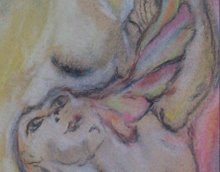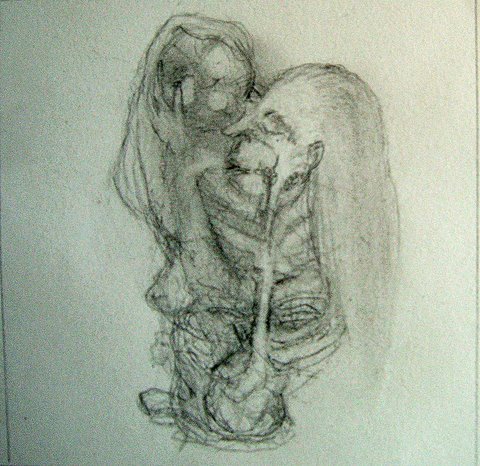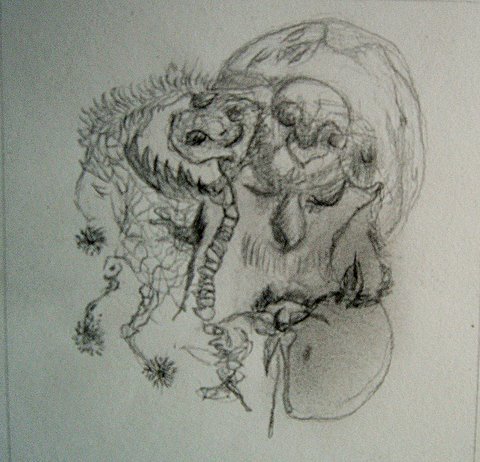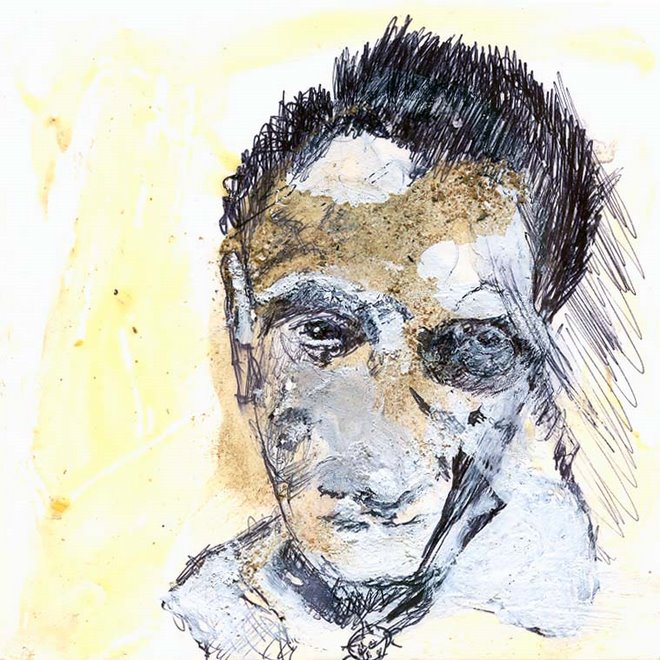"we talked late into the night, arguing whether or not we too have journeys mapped out in our central nervous systems... " -- Bruce Chatwin, In Patagonia
We speak of aboriginal cultures and native populations only because a disrupted isolation shouts back at us: dwelling in a remote location over centuries, eventually breached, broken, infilitrated and, sadly, in most cases, not transformed into a greater compassionate family conglomeration; instead the intrusion caused stress, marginalizing, displacing or eradicating aboriginals, colonizing and deforming their lands and psyches. And yet there are survivors of the wreckage. There are stories. There must have been an island and there must have been an ocean. There must have always been someone, even creatures of other species, emerging from, crossing over the ocean and making their way into the land masses of previously unknown creatures... insects, spores, bacteria...
There must have always been water within us and without
(crossing wave fronts, actually, equally unknown creatures themselves, the conquistadores, coming from afar, also aliens for the aboroginals -- and perhaps we only know ourselves via the experience unknown and vice versa, as intermingling aliens
All of the creatures must have had maps of their media, carried within their bodies somewhere. Whether the medium was land or the sea, they negotiated passages, they constructed imaginary bridges and mental stairways, not only horizontally but vertically. Creatures who gained verticality via their spinal erection threw their head bubbles up into the heavens and eventually numerically charted the rise and fall of celestial objects greater and smaller. Who among us keeps these maps in mind or at heart for quick access can help us navigate the coming unknowns perhaps. Here, in this blog, I try to assemble some resemblance of their ways of knowing and feeling, of our shared ancestral blog, as it evolves
Here is a field recording from Australia Victoria Square
https://soundcloud.com/hearingbeings/victoria-square-tarndanyangga?in=hearingbeings/sets/victoria-square-tarndanyangga
Hearing Beings, a project I just discovered today -- thanks to Khristos Nizamis -- allows us to see with our ears the post-colonial sonosphere and an imagination of the pre-colonial ancestors and by extreme contrast, the sound inside a flagpole in the square that commemorates indigenous tribes either scattered or no longer there. There is much more to hear on the Hearing Beings page n SoundCloud, so listen further when you have time -- the Kangaroo Island sequence may even be a soothing background as you read the rest of this post.
https://soundcloud.com/hearingbeings/sets/kangaroo-island-natural-sounds-and-soundscapes
ABORIGINAL LAND MASSIVES
I found the following excerpt from
'The Dust of the Mindye' by Jim Poulter --PhD.M.S.W. Dip.Crim. Dip. Soc.Stud. MAASW
-- floating around Facebook one day and was moved by those words...
(Jim Poulter is the author of more than twenty novels, children's books,
local histories and academic texts. Jim's forebears first settled in
Wurundjeri Country in Melbourne's Yarra Valley in 1840 and established a
close relationship with the local Aboriginal people)
"Aboriginal population matched the carrying capacity of the land because they saw their primary mandate as caring for the land and each other, their society was focused on the development of sophisticated technologies for land management, resource husbanding
and population control.
The structure of Aboriginal society also reflected these ecological considerations and eldership was attained not simply through age, but by demonstrated and accumulated merit in both religious and secular knowledge. There was therefore no division between church and state, because elders had to demonstrate a unified knowledge base as well as a communal approach to decision making.
Through this blending of spiritual and secular authority in a system of eldership. Aboriginal society might be best described as a 'Druidic Meritocracy'. It was therefore a truly communalist society with no individual or specific group having control over resources.
There was no individual accumulation of wealth or power and as a consequence there was conversely no accumulated poverty or disadvantage. there were no social class differences apart from the respect due to age and merit, and as indicated. decision making was by consensus rather than edict.
All tribal areas were based on water catchment areas and the totemic system was utilised as a means of species conservation and land management.' The totem system therefore had a primary ecological purpose and all knowledge was integrated through the totem system to serve that primary ecological purpose.
This ecological focus was achieved by the universal way in which the totem system was structured across Australia and in turn how this determined the structure of Aboriginal society itself. Aboriginal family kinship was therefore an integral part of their system of ecological relationship and control. Aboriginal people therefore saw human society as an interdependent part of the whole ecology and not separate from or holding dominion over it.
For instance in all Aboriginal societies a Yin and Yang type of conceptual division existed, where every living and non living thing was divided between these two halves or 'moieties'. At the simplest level (and there were several ritual exceptions) this meant that an individual was not allowed to hunt or eat any of the animals in their own moiety. because they were his or her spirit cousins.
In this way at least half the food sources were taboo to an individual and for instance it might mean you could eat wallaby but not grey kangaroo, or ring-tailed possum but not brush-tailed possum. As indicated, the totem system also governed marriage and family relationships and together with common male and female contraceptive practices, all tribes ensured that their population remained consistent with the natural carrying capacity of the land.
This was however not just the carrying capacity of the land in a good or average year, but in the worst of years. For Aboriginal people abundance was the norm.' These land management and population control practices therefore meant that prior to British settlement in 1788 Aboriginal people in Australia enjoyed the highest common standard of living of any people in the world."
BACK TO THE WHEEL
==============
If you didn't get enough from the above article to forget about such trite stuff as who invented the wheel, we feel sorry for you, but here we go ...
There are historical arguments about where the wheel came from, but a popular belief is that a wheel was first recorded in the middle east, in Mesopotamia (now Iraq) around the 4th century BC.
Another popular belief is it that the wheel was first used in Mesopotamia an historical region of Western Asia around 3500 BC.
The wheel certainly didn't first arrive on the shores of this continent by the British, it is well known that many ships arrived before 1770, and some of these even traded with First Nations people for centuries, and most of the vessels had wheels for many uses, but as it turned out, no First Nations tribe or clan had any continuous need for the wheel over the 70,000+ years.
THE GREAT WHEEL OF THE TIDES
But what of the Sea, what of the Ocean... what are it's rhythms and how did knowing them create colonialist enterprise and how through knowing the great power of he isolating medium can this knowledge be the creative force for a new balance?
From "The Repeating Island" by Antonio Benitez-Rojo
"The culture of the Peoples of the Sea is a flux interrupted by rhythms which attempt to silence the noises with which their own social formation interrupts the discourse of Nature. . . . The cultural discourse of the Peoples of the Sea attempts … to neutralize violence and to refer society to the transhistorical codes of Nature. . . . The culture of the Peoples of the Sea expresses the desire to sublimate social violence through referring itself to a space that can only be intuited through the poetic, since it always puts forth an area of chaos. In this paradoxical space, in which one has the illusion of experiencing a totality, there appear to be no repressions or contradictions; there is no desire other than that of maintaining oneself within the limits of this zone for the longest possible time, in free orbit, beyond imprisonment or liberty.
—THE REPEATING ISLAND: THE CARIBBEAN AND THE POSTMODERN PERSPECTIVE










